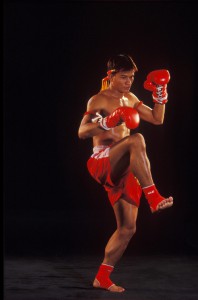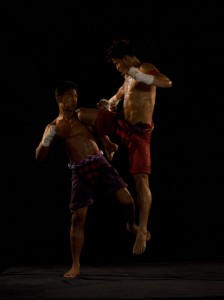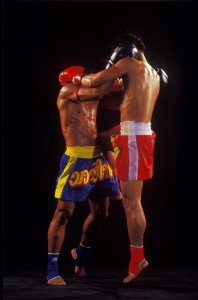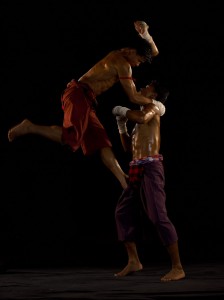Muay Thai
Muay Thai
 Thai boxing, or Muay Thai as the Thai people call it, is a traditional art of self defense of the Thais. It is different from international boxing in that in the Thai style of unarmed fighting, feet, elbows and knees are used as well as fists. Thus, it resembles more to a real free- for-all fight and is therefore considered superior to international boxing as an art of self defense. As it is more exacting, a Thai boxing match lasts only five rounds of three minutes each, with a two-minute rest between rounds.
Thai boxing, or Muay Thai as the Thai people call it, is a traditional art of self defense of the Thais. It is different from international boxing in that in the Thai style of unarmed fighting, feet, elbows and knees are used as well as fists. Thus, it resembles more to a real free- for-all fight and is therefore considered superior to international boxing as an art of self defense. As it is more exacting, a Thai boxing match lasts only five rounds of three minutes each, with a two-minute rest between rounds.
Since ancient times the Thai rulers have attached great importance to the training of their soldiers and the ordinary people in the skills of hand-to-hand fighting, both with and without weapons. While the latter is known as muay, the former is called krabi-krabong, literally sword and baton, though the weapons used are not limited to these two. Very often, the rulers themselves were great fighters–strong, valiant and skilled in the art.
Whether in times of war, when it was necessary to confront enemies, or in peaceful times, when emphasis was placed on preparation, self-defense techniques have always been of great importance to military leaders and to the monarchy. This is because, down through the ages, fighting wars have often come down to hand-to-hand combat in which weapons and methods of combat change rapidly and unexpectedly until a winner and loser emerge.
Thai boxing is a weapon that is always at the ready. It is the ancestor of all other types of weapons, and is superior to them all. Any combatant who doesn’t know how to use such natural weapons, even though he is skilled in the use of external and artificial weapons, will be at a disadvantage to the fighter who can use both.
Wai Khru Ram Muay Ceremony “Ritual Dance of Homage to Teachers”
The uniqueness and universal attractiveness of Muay Thai lies partly in the fact that not only is it a highly efficient martial art form, but it is also infused with Thai cultural values woven in a seamless manner, thus making Muay Thai a reflection of some of the intrinsic qualities of Thai society.
The Wai Khru or Paying Respect to the Teachers Ceremony is an ancient Thai tradition closely bound with the fundamental concept that all providers of knowledge are Khru or teachers, and are worthy of the highest respect.
That respect is expressed in the spiritual, graceful, and highly symbolic Wai Khru Ram Muay, the “Ritual Dance of Homage to Teachers”, accompanied by traditional music and immediately prior to the fight.
To see a Wai Khru Ceremony, please click here
Muay Thai en el Escenario Global
 Promoters arranged for Muay Thai fighters to go to theUSand other countries, to stage exhibition matches and even to organize tournaments between Muay Thai fighters and practitioners of other martial arts such as karate and Western boxing. In the late 1950s, a Japanese boxing promoter became fascinated with Muay Thai and studied it closely.
Promoters arranged for Muay Thai fighters to go to theUSand other countries, to stage exhibition matches and even to organize tournaments between Muay Thai fighters and practitioners of other martial arts such as karate and Western boxing. In the late 1950s, a Japanese boxing promoter became fascinated with Muay Thai and studied it closely.
He then devised a concept of Japanese kick-boxing, fusing Muay Thai kicking techniques with aspects of karate and Western boxing. Later, his troupe of Japanese kick-boxers fought with Muay Thai fighters. He also introduced this kind of competition inEurope, creating some confusion there as Japanese kick-boxing was seen as synonymous with Muay Thai, although in reality they are quite different in terms of conceptual and cultural breadth and depth.
It was in the 1970s that Muay Thai began to flourish internationally. At that time, the oriental martial arts, in general, had a large following, spurred by the popularity of movies starring the Kung-Fu king, Bruce Lee.
Thai boxing rode on the crest of this wave and Muay Thai gyms were established in many countries, especially, theUS,Germany, theNetherlands, andAustralia. It has become well established as the premier martial arts globally, as evidenced by the proliferation of Muay Thai clubs with sites in the worldwide web.
World championship matches comparable to those of Western boxing are being held regularly. Muay Thai has come to be acclaimed “the King of the Martial Arts”.
Muay Thai in México
 Before 2004, this martial art was not well known in Mexico but from the arrival of Professor Supakit Malisorn, (nephew of Mr Chirachai Pangsri owner of the first Thai food restaurant in Mexico and Latin America) were disseminated among the Mexican population.
Before 2004, this martial art was not well known in Mexico but from the arrival of Professor Supakit Malisorn, (nephew of Mr Chirachai Pangsri owner of the first Thai food restaurant in Mexico and Latin America) were disseminated among the Mexican population.
Professor tells us more about that in the following interview:
What is your experience in Muay Thai?
A: I started practicing Muay Thai at 12 years old , I have participated in national championships inBangkokand provinces of Thailand. From 47 fights I have been 39 times victorious. InMexicoi participated in the championships of Torreón (2005)Campeche(2006)Toluca(2007) and later dedicated myself only to educate and spread the martial art inMexico.
How did you spread it in Mexico?
A: When I arrived in Mexico in 2004 my uncle, Mr Srichai Pangsri supported me to attend to TV programs and Mexican Press to make some promotion and then i attended different schools of martial arts in Mexico City, Merida, Cancun, Campeche, Torreón, Leon, Toluca, Chiapas, Gdl and some other places. I was also a trainer at the Department of Public Safety and I have attended in many shows and fairs inMexico City and provinces.
Who is recommended this martial art?
A: It is an activity that can make all people because it is a martial art, self defense system, a professional and amateur sport, as well as one of its most innovative, is a fitness activity.
Muay Thai is much more than just learning to fight: it is a strong and vigorous martial art that teaches self-discipline and self-control that allows for the self-confidence necessary to thrive in daily life.
Sources:
- Thailand: Traits and Treasures. The National Identity Board, Royal Thai Government 2005.
- The Origins of Thai Boxing by Panra Kratius & Dr. Pitisuk Kraitus
- A Brief History of Thai Boxing By Thawat Watthana



